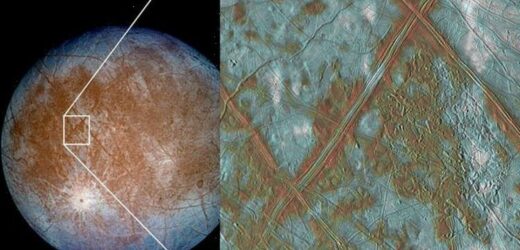NASA: Hubble observes Jupiter’s great red spot changing
We use your sign-up to provide content in ways you’ve consented to and to improve our understanding of you. This may include adverts from us and 3rd parties based on our understanding. You can unsubscribe at any time. More info
The incredible discovery was made possible thanks to NASA’s Hubble Space Telescope. Using imagery and data taken by the space probe from 1999 to 2015, a researcher from the European Space Agency (ESA) found water vapour covering a large part of the moon’s trailing hemisphere. The presence of water on Europa has been known since 2013, but this new discovery shows it is far more persistent than initially thought.
Lorenz Roth, the sole author of the study from KTH Royal Institute of Technology, Space and Plasma Physics, said: “The observation of water vapour on Ganymede, and on the trailing side of Europa, advances our understanding of the atmospheres of icy moons.
“However, the detection of a stable water abundance on Europa is a bit more surprising than on Ganymede because Europa’s surface temperatures are lower than Ganymede’s.”
Strangely, the observation has only been on one hemisphere.
The water vapour is on the trailing hemisphere, the portion of the moon that is always opposite its direction of motion on its orbit.


Europa is the smallest of the four Galilean moons orbiting Jupiter, and the sixth-closest to the planet of the 79 that have been identified by NASA.
Slightly smaller than Earth’s Moon, Europa is primarily made of silicate rock, has a water-ice crust and what researchers think is an iron-nickel core.
It has a very thin atmosphere, composed primarily of oxygen and its smooth surface has led scientists to hypothesise that a water ocean exists beneath the surface.
To make the new discovery, Mr Roth delved into archival Hubble datasets, selecting ultraviolet observations of Europa from 1999, 2012, 2014 and 2015 while the moon was at various orbital positions.

These observations were all taken with Hubble’s Space Telescope Imaging Spectrograph (STIS).
The ultraviolet STIS observations allowed Mr Roth to determine the abundance of oxygen – one of the constituents of water – in Europa’s atmosphere, and by interpreting the strength of emission at different wavelengths he was able to infer the presence of water vapour.
The new findings add to a growing suspicion that the planet could harbour alien life.
DON’T MISS
Archaeology breakthrough as ‘lactose intolerant’ mummy discovered [REVEAL]
EU plots to STOP Arctic oil drilling after Putin exposed vulnerability [INSIGHT]
Covid breakthrough: ‘Highly potent’ antibody found to kill virus [REPORT]


In 2020, a British scientist said that alien life on Europa was “almost a racing certain”, adding that he thought there could be “octopus” creatures there.
And in May this year it was discovered that one of Europa’s ice shells could have pockets of water lurking beneath.
Mr Roth’s study, published in the journal Geophysical Research Letters, will be of interest to NASA and the ESA given that both agencies have upcoming missions to Jupiter.
Source: Read Full Article


